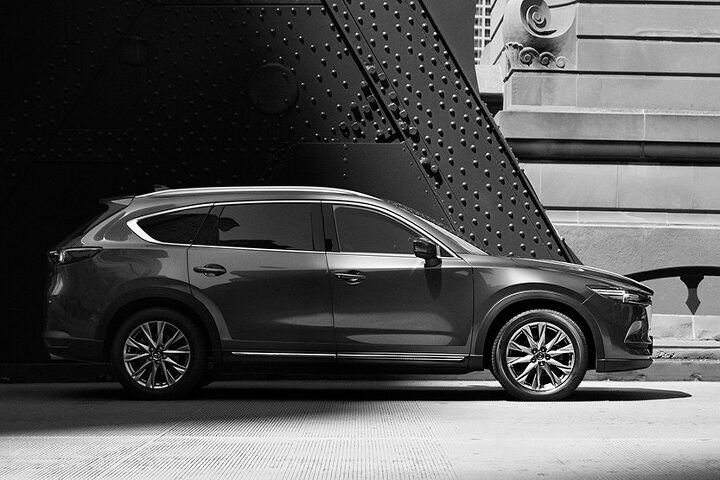And Now It's Obvious Why the Mazda CX-8 Won't Be Imported to America
First, we heard about the Mazda CX-8.
Then the Mazda CX-8 was spotted on the streets of Chicago, Illinois. Which is in the United States.
And then Mazda confirmed that the CX-8 would most definitely not be exported from Japan. As the CX-4 was a China-oriented model, the CX-8 would be geared towards a Japanese market for which the CX-9 is just too big. But then we heard the Mazda CX-8 might be exported from Japan, but only to Australia.
And now, with official imagery, it’s not difficult to understand why Mazda USA has no need for the CX-8. It looks almost exactly like a CX-9 with six fewer inches of length, five fewer inches of width, and a marginally lower roofline.
Americans do not need a smaller Mazda CX-9.
There’s reason to believe Mazda could use more utility vehicles in North America. Aye, couldn’t every automaker?
Mazda has quickly become more reliant on its CX lineup for U.S. sales, earning 54 r drcent of its first-half sales from the CX-3, CX-5, and CX-9 in 2017, up from 45 percent a year ago. As the Mazda 3 and Mazda 6 use vast chunks of already limited sales — they’ve combined for 17,000 fewer sales in 2017’s first six months than during the same period of 2016 — Mazda requires healthy CX volume to keep its dealers active.
In June, for example, the average Mazda dealer sold only 16 passenger cars; on par with Ford but well back of brands such as Kia (43), Hyundai (36), Volkswagen (35), and Subaru (24). The average Mazda franchise sold only 36 total vehicles in June, fewer sales per dealer than 15 other auto brands, according to Automotive News Data Center.
Unfortunately, the two latest Mazda utility vehicles — the CX-4 and now CX-8 — aren’t destined for North America. Much as Mazda would like to get the swoopier CX-5 that Mazda China markets as the CX-4 on that side of the Pacific, it’s not to be.
As for the Mazda CX-8, “They are closely related, but they serve different audiences that suit the different tastes (and road widths) of their respective buyers,” Mazda spokesperson Jacob Brown told TTAC in May. Now we see just what Brown meant by “closely.”
Attempting to determine the differences between the Mazda CX-8 and CX-9 would be challenging enough for a potential Mazda crossover buyer. Determining why the more cramped CX-8 is worthy of hard-earned American dollars would be altogether more difficult, especially since the Mazda CX-9 is already deserving of cabin criticism.
* This article was updated to clarify that the average Mazda dealer sold 36 vehicles in June, not 36 vehicles per day in June.
[Images: Mazda]
Timothy Cain is a contributing analyst at The Truth About Cars and Autofocus.ca and the founder and former editor of GoodCarBadCar.net. Follow on Twitter @timcaincars.
More by Timothy Cain
Latest Car Reviews
Read moreLatest Product Reviews
Read moreRecent Comments
- Jalop1991 is this anything like a cheap high end German car?
- HotRod Not me personally, but yes - lower prices will dramatically increase the EV's appeal.
- Slavuta "the price isn’t terrible by current EV standards, starting at $47,200"Not terrible for a new Toyota model. But for a Vietnamese no-name, this is terrible.
- Slavuta This is catch22 for me. I would take RAV4 for the powertrain alone. And I wouldn't take it for the same thing. Engines have history of issues and transmission shifts like glass. So, the advantage over hard-working 1.5 is lost.My answer is simple - CX5. This is Japan built, excellent car which has only one shortage - the trunk space.
- Slavuta "Toyota engineers have told us that they intentionally build their powertrains with longevity in mind"Engine is exactly the area where Toyota 4cyl engines had big issues even recently. There was no longevity of any kind. They didn't break, they just consumed so much oil that it was like fueling gasoline and feeding oil every time



































Comments
Join the conversation
Bring it so the car blogs can complain about how similar it is in size to the next model up or down... ;)
The reason Australia is getting the CX-8 whilst also having the CX-9 is that although Australia loves the CX-9, those who have driven the CX-5 diesel want a diesel CX-9 version - and Mazda is not making one. It was a US specific model that they just happened to make LHD because Australia is a high selling Mazda country (Mazda is 2nd highest selling brand). Meanwhile the CX-8 is diesel only for the Japanese market (because they fell in love with the CX-5 diesel too). So Australia will get the CX-8 with almost no changes. It's a win-win. Large size and diesel.